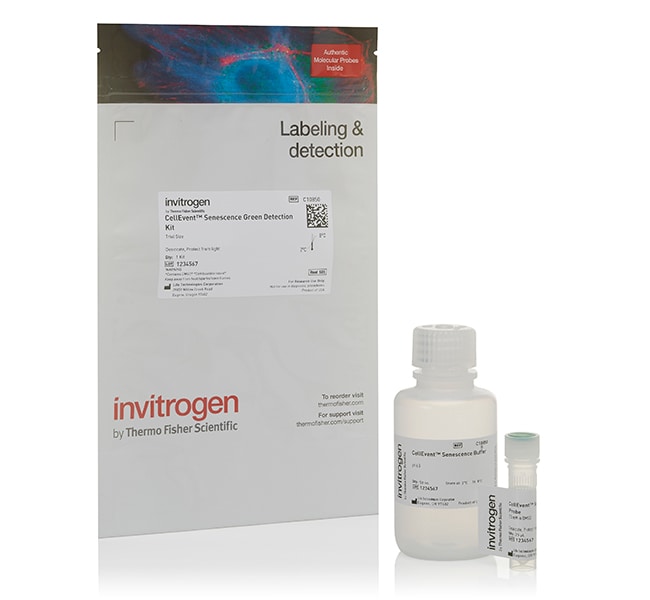Search Thermo Fisher Scientific
Invitrogen™
CellEvent™ Senescence Green Detection Kit
카탈로그 번호: C10850
Have Questions? 
Invitrogen™
CellEvent™ Senescence Green Detection Kit
카탈로그 번호: C10850
Have Questions? 카탈로그 번호
C10850
제품 사이즈
25 µL
제품 정가(KRW)
제품 정가 561,000
온라인 행사 533,000
(01-Oct-2024에 종료)
공급가
재고 정보
-
수량
수량
| 카탈로그 번호 | 제품 사이즈 | 제품 정가(KRW) | 재고 정보 | 수량 | |
|---|---|---|---|---|---|
| C10850 | 25 µL | 제품 정가 561,000 온라인 행사 533,000 (01-Oct-2024에 종료) 공급가 | - | ||
| C10851 | 100 µL | 제품 정가 1,000,000 온라인 행사 900,000 (01-Oct-2024에 종료) 공급가 | - |
제품 개요
그림
동영상
관련 제품 추천
관련 제품 추천
문서
FAQ
인용 및 참조 문헌
추가 정보
관련 제품 추천
The CellEvent Senescence Green Detection Kit consists of a fluorescent probe and optimized buffer that enable the image-based detection of senescent cells. The fluorescein-based probe contains two galactoside moieties, making it a target for β-galactosidase. Activation of β-galactosidase is commonly used as a biomarker for senescent cells. This hydrolase enzyme resides in lysosomes and converts β-galactosides into monosaccharides under acidic pH conditions. The enzymatically cleaved product is retained within the cell due to covalent binding of intracellular proteins and emits a fluorogenic signal that has absorption/emission maxima of 490/514 nm.
CellEvent Senescence Green Detection Kit features include:
• Reliable and quick fluorescent detection of senescent cells
• Greater sensitivity than traditional colorimetric x-gal
• Fluorescent signal is well retained and detected using standard Alexa Fluor 488/FITC filter sets
• Multiplex-enabled—fluorescent senescence probe can be multiplexed
Due to a limited replicative lifespan, normal cells enter cell cycle arrest, also known as cellular senescence. While in this senescent phase the cells remain metabolically active without undergoing cell death or division. They adopt a specific phenotypic that includes the appearance of multiple nuclei, increased vacuolization, expression of pH-dependent β-galactosidase, and morphological enlargement and extension. Senescence, through a variety of mechanisms, may play a role in tumor suppression, tumor progression, aging, and tissue repair.
Activation of β-galactosidase is commonly used as a biomarker for senescent cells. This hydrolase enzyme resides in lysosomes and converts β-galactosides into monosaccharides under acidic pH conditions. The activity is optimal at lysosomal pH 4, but conventional assays measure at pH 6. It has been shown that normalized β-galactosidase activity is twice as high in senescent cells as in pre-senescent cells regardless of the pH value used for testing.
A colorimetric substrate for β-galactosidase, 5-bromo-4-chloro-3-indolyl-β-D-galactopyranoside (x-gal), has long been used to detect metabolic activity in cells in vitro. However, its use is limited due to inconsistent signal, length of assay, and inability to multiplex.
Therefore, we have developed a sensitive, fluorescent substrate for β-galactosidase that can be used for the detection of senescent cells. The CellEvent Senescence Green probe is a fluorescein-based reagent that contains two galactoside moieties, making it a specific target of β-galactosidase. The enzyme- cleaved product is retained within the cell due to covalent binding of intracellular proteins and emits a fluorogenic signal that has absorption/emission maxima of 490/514 nm.
The CellEvent Senescent Green Kit provides CellEvent Senescent Green probe and an optimized buffer for the detection of senescent cells in fixed samples. This probe can be multiplexed with other fluorescent reagents compatible with paraformaldehyde fixation.
CellEvent Senescence Green Detection Kit features include:
• Reliable and quick fluorescent detection of senescent cells
• Greater sensitivity than traditional colorimetric x-gal
• Fluorescent signal is well retained and detected using standard Alexa Fluor 488/FITC filter sets
• Multiplex-enabled—fluorescent senescence probe can be multiplexed
Due to a limited replicative lifespan, normal cells enter cell cycle arrest, also known as cellular senescence. While in this senescent phase the cells remain metabolically active without undergoing cell death or division. They adopt a specific phenotypic that includes the appearance of multiple nuclei, increased vacuolization, expression of pH-dependent β-galactosidase, and morphological enlargement and extension. Senescence, through a variety of mechanisms, may play a role in tumor suppression, tumor progression, aging, and tissue repair.
Activation of β-galactosidase is commonly used as a biomarker for senescent cells. This hydrolase enzyme resides in lysosomes and converts β-galactosides into monosaccharides under acidic pH conditions. The activity is optimal at lysosomal pH 4, but conventional assays measure at pH 6. It has been shown that normalized β-galactosidase activity is twice as high in senescent cells as in pre-senescent cells regardless of the pH value used for testing.
A colorimetric substrate for β-galactosidase, 5-bromo-4-chloro-3-indolyl-β-D-galactopyranoside (x-gal), has long been used to detect metabolic activity in cells in vitro. However, its use is limited due to inconsistent signal, length of assay, and inability to multiplex.
Therefore, we have developed a sensitive, fluorescent substrate for β-galactosidase that can be used for the detection of senescent cells. The CellEvent Senescence Green probe is a fluorescein-based reagent that contains two galactoside moieties, making it a specific target of β-galactosidase. The enzyme- cleaved product is retained within the cell due to covalent binding of intracellular proteins and emits a fluorogenic signal that has absorption/emission maxima of 490/514 nm.
The CellEvent Senescent Green Kit provides CellEvent Senescent Green probe and an optimized buffer for the detection of senescent cells in fixed samples. This probe can be multiplexed with other fluorescent reagents compatible with paraformaldehyde fixation.
For Research Use Only. Not for use in diagnostic procedures.
사양
세포 유형
Mammalian Cells
검출 방법
Fluorescence
용도 (장비)
Fluorescence Microscope, High Content Analysis Instrument
제품 유형
Senescence Green Detection Kit
형식
96-well plate
제품라인
CellEvent™
수량
25 μL
배송 조건
Approved for shipment at Room Temperature or on Wet Ice
Unit Size
25 µL
구성 및 보관
Store at 2–8°C and protect from light.
그림
문서 및 다운로드
Certificates | 증명서
Lot 번호 또는 부분 Lot 번호로 검색하십시오.
자주 묻는 질문(FAQ)
인용 및 참조 문헌
Search citations by name, author, journal title or abstract text